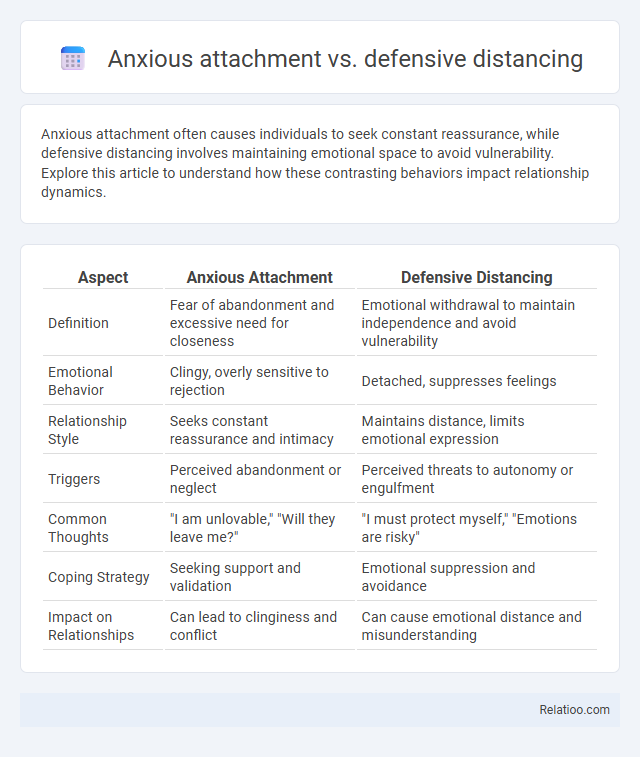Anxious attachment often causes individuals to seek constant reassurance, while defensive distancing involves maintaining emotional space to avoid vulnerability. Explore this article to understand how these contrasting behaviors impact relationship dynamics.
Table of Comparison
| Aspect | Anxious Attachment | Defensive Distancing |
|---|---|---|
| Definition | Fear of abandonment and excessive need for closeness | Emotional withdrawal to maintain independence and avoid vulnerability |
| Emotional Behavior | Clingy, overly sensitive to rejection | Detached, suppresses feelings |
| Relationship Style | Seeks constant reassurance and intimacy | Maintains distance, limits emotional expression |
| Triggers | Perceived abandonment or neglect | Perceived threats to autonomy or engulfment |
| Common Thoughts | "I am unlovable," "Will they leave me?" | "I must protect myself," "Emotions are risky" |
| Coping Strategy | Seeking support and validation | Emotional suppression and avoidance |
| Impact on Relationships | Can lead to clinginess and conflict | Can cause emotional distance and misunderstanding |
Understanding Anxious Attachment
Anxious attachment stems from a deep fear of abandonment and a heightened need for reassurance, causing you to seek constant closeness and validation in relationships. Defensive distancing emerges as a coping mechanism where individuals create emotional space to protect themselves from perceived rejection or vulnerability. Understanding anxious attachment is essential for recognizing how these behaviors impact your emotional responses and relationship dynamics, enabling healthier coping strategies.
What is Defensive Distancing?
Defensive distancing is a psychological coping mechanism where individuals intentionally create emotional or physical space to protect themselves from perceived threats or discomfort in relationships. Unlike anxious attachment, which involves fear of abandonment and seeks closeness, defensive distancing serves as a barrier to intimacy to avoid vulnerability. This behavior often manifests as withdrawal, reduced communication, or emotional guardedness to maintain self-protection.
Core Differences Between Anxious Attachment and Defensive Distancing
Anxious attachment is characterized by a heightened need for closeness and reassurance, often leading to clinginess and fear of abandonment. Defensive distancing, on the other hand, involves creating emotional space to protect oneself from perceived threats, resulting in withdrawal and avoidance. Core differences between anxious attachment and defensive distancing lie in their opposing relational behaviors: anxious attachment seeks intimacy, while defensive distancing promotes detachment as a self-protection mechanism.
Psychological Roots of Anxious Attachment
Anxious attachment originates from inconsistent caregiving, where caregivers are unpredictably responsive, leading to heightened fears of abandonment and a relentless need for reassurance. Defensive distancing emerges as a protective mechanism, where individuals maintain emotional space to avoid vulnerability and potential rejection. Understanding these psychological roots helps you recognize patterns of clinginess and withdrawal, fostering healthier emotional connections.
How Defensive Distancing Develops
Defensive distancing develops as a coping mechanism in response to perceived emotional threats, often rooted in early attachment disruptions or inconsistent caregiver responsiveness. Individuals exhibiting defensive distancing create emotional space to protect themselves from vulnerability and potential rejection, contrasting with anxious attachment where heightened closeness and fear of abandonment predominate. This defense evolves through repeated relational experiences that reinforce withdrawal as a safer strategy to manage interpersonal stress and maintain self-protection.
Behavioral Patterns in Relationships
Anxious attachment manifests through behaviors such as clinginess, constant need for reassurance, and heightened sensitivity to perceived rejection in relationships. Defensive distancing, often a protective response, involves emotional withdrawal, reduced communication, and physical or psychological space to avoid vulnerability. These behavioral patterns significantly impact relationship dynamics by either increasing dependency and conflict or fostering detachment and emotional disconnect.
Signs and Symptoms to Recognize
Anxious attachment manifests through intense fear of abandonment, constant need for reassurance, and heightened sensitivity to relationship cues, often causing emotional turbulence. Defensive distancing is characterized by emotional withdrawal, avoiding intimacy, and maintaining physical or psychological space to protect oneself from perceived threats. Recognizing Your patterns involves noticing signs like clinginess or avoidance, mood swings linked to partner interactions, and discomfort with vulnerability or closeness.
Impact on Emotional Wellbeing
Anxious attachment often leads to heightened emotional distress, as individuals may experience intense fear of abandonment and constant need for reassurance, which undermines emotional stability. Defensive distancing, characterized by emotional withdrawal and avoidance, can protect individuals from immediate emotional pain but frequently results in increased feelings of loneliness and suppressed emotions over time. Both anxious attachment and defensive distancing negatively impact emotional wellbeing by disrupting healthy interpersonal connections and fostering patterns of insecurity and emotional disconnection.
Strategies for Healing and Growth
Anxious attachment often requires strategies like developing emotional regulation skills, fostering secure relationships, and practicing mindfulness to reduce dependency and insecurity. Defensive distancing is best addressed by gradually increasing vulnerability, enhancing self-awareness, and building trust through consistent, honest communication. Healing from both involves therapy approaches such as cognitive-behavioral therapy (CBT) and attachment-based therapy that promote emotional resilience, self-compassion, and healthier relational patterns.
Seeking Professional Help and Support
Seeking professional help is crucial for individuals experiencing anxious attachment and defensive distancing, as therapists can provide tailored strategies to improve emotional regulation and interpersonal communication. Cognitive-behavioral therapy (CBT) and attachment-based therapy offer evidence-based interventions targeting the underlying fears and avoidance patterns characteristic of these attachment styles. Accessing support groups and counseling can also enhance coping skills, foster self-awareness, and promote healthier relationship dynamics.

Infographic: Anxious attachment vs defensive distancing
 relatioo.com
relatioo.com